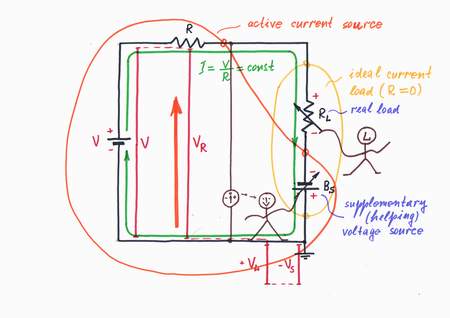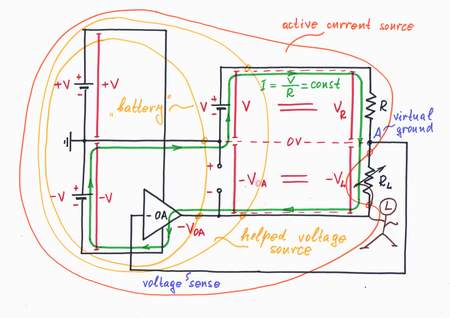<< prev story circuit-fantasia > circuit stories > understanding circuits > inverting op-amp current source next story >>
What is the idea behind this circuit?
Inverting Op-Amp Current Source
Ideas: Keeping a constant current by adding a voltage (removing voltage by an "antivoltage", helping the input voltage source, zeroing resistance)
In the simple current source the voltage drop VL across the load affects the current. We have already solved this problem by varying the internal resistance and the excitation voltage. Let's now look for another remedy.
What do we do in our routine when an obstacle stands in our way? We just remove it by an equal useful "antidisturbance"!
Following this powerful idea, we may compensate the harmful voltage VL with an equival "antivoltage" -VL. For this purpose, we have just to connect an additional supplementary voltage source Bs in series with the load and adjust its voltage -Vs = VL. As a result, the total excitation voltage V is constantly applied across the resistor R and a steady current I = V/R flows through the load.
If we draw the additional supplementary voltage source Bs under the main source V, we will see that the two voltage sources are connected in series, in one and the same direction (+ -, + -) so that their voltages are added. So, the additional source Bs helps the excitation voltage source V injecting exactly as much voltage -Vs as it (VL) drops across the load.
Implementation: Connecting an inverting op-amp follower in series with the load, in order to act as a supplementary voltage source.
This idea is implemented in the circuit of an op-amp inverting amplifier acting as a current source. Here, the op-amp doses the voltage of the power supply thus producing a compensating voltage -VL (the combination of an op-amp and a steady battery -V acts as a varying battery BS).
The op-amp "observes" the potential of the point A (the difference between the two voltages) and changes instantly its output voltage so that the point A (the so called virtual ground) stays always at zero volts. Doing that, the op-amp compensates the "harmful" voltage drop VL across the load.
Note that the simple current source V-R is "fooled". It doesn't "understand" that there is a load connected; it "thinks" that its output is shorted. As a result, a steady current I = V/R flows through the load.
As before, if we draw the supplementary op-amp voltage source under the main source V, we will see that the op-amp voltage source is connected in series to the excitation voltage source V so that their voltages are added. In this way, the op-amp helps the excitation voltage source V by copying the voltage drop VL across the load and adding it to the main voltage V.
<< prev story circuit-fantasia > circuit stories > understanding circuits > inverting op-amp current source next story >>




